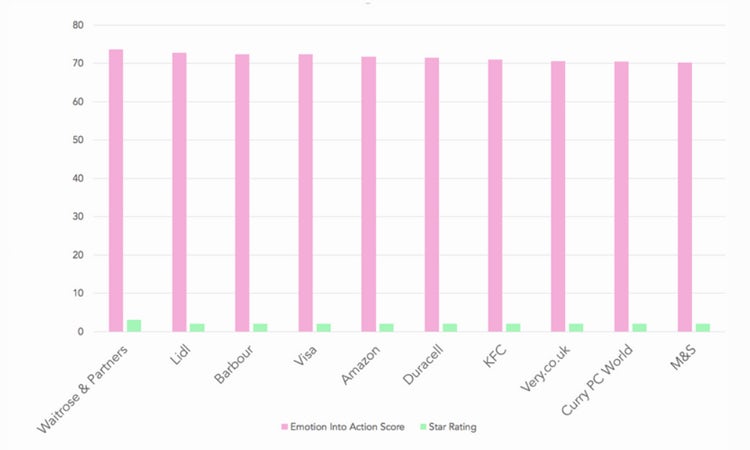Heathrow tops Christmas ad list amid lacklustre year for festive campaigns
Is this the worst Christmas ad season on record? Data reveals that less than half the number of ads compared with last year have scored three stars or more – with John Lewis just scraping into the top 10.
Oh dear. It looks like this year’s selection of Christmas ads, which have seen Kevin the Carrot face-off with a wicked parsnip, Elton John travel back in time to the moment where it all started, and Holly Willoughby shamelessly plug some ‘must-have’ jumpers, have failed to get festive pulses racing.
Just 29% of campaigns got three stars or more out of five, according to data from System1, half the 59% that scored at least three stars last year and making 2018 the worst year since the company began measuring Christmas ads. The score is calculated by asking people how they feel about the ad and how intensely they feel, ultimately predicting long-term brand impact on market share and likelihood of purchasing.
The fall suggests a couple of trends are at work. On the consumer side, people simply aren’t in the mood, whether for reasons around Brexit, the economy, or wanting to be more careful with spending. And on the marketing side the quality and emotional resonance of the ads just isn’t as strong this year, especially as many brands have abandoned the usual heart-warming epics in favour (mostly out of necessity) of product-focused ads.
Heathrow comes out on top

The only ad to achieve a four-star rating this year is Heathrow’s ‘Bears Return’, back for the third year, which came out on top with a score of 79.6.
Verbatim consumer responses included: “I loved it”, “it was so festive and heart-warming”, “good old teddy” and “great ad, hope they don’t go on strike”.
Coca Cola’s classic ‘Holidays are Coming‘ ad came second with a score of 76.9 giving it a three-star rating, followed closely by Sainsbury’s ‘The Big Night‘ (76.5) and Asda’s high-speed ‘Bring Christmas Home‘ (76.3).
Cadbury and Boots also scored three stars, while Aldi’s Kevin the Carrot – having avoided a near-puree crisis – picked up three stars for the third year in a row.
Brands really need to raise their game if they’re going to stick with the big blockbuster storytelling and move above that.
Tom Ewing, System1
John Lewis’s highly-anticipated Elton John ad only just scraped into the top 10 with three stars. That is a big dip compared with previous ads that have had more of a festive narrative; Monty the Penguin scored five stars in 2014 and consumers were left seemingly confused this year and interpreted it as too much Elton John and too little John Lewis and Christmas.
Meanwhile, Iceland’s re-purposed Greenpeace film about palm oil exploitation, which didn’t make it on to TV but resulted in 50 million online views and a million-signature petition, came right at the bottom of the table with one star and a score of just 46.1 – significantly lower than the second lowest-scoring ad which was JD Sport’s #IAMJD (62.6).
Has the focus on product over brand paid off?
It is no secret that retailers have pulled back spend this year amid the challenging retail landscape, and there has been a much stronger focus on products and commercial promotions.
The results of this change in tact have been mixed. M&S’ food-based ad got three stars for its still-food-porny shots of food (in spite of the increased focus on value), although this is a step down from Paddington and Mrs Claus which both got four stars.
M&S’s main clothing and home campaign starring Holly Willoughby and David Gandy, however, only made it to number 20 with two stars.

Other brands in the two-star bracket include Lidl, Amazon, KFC and Tesco, while Debenhams’s departure from “vanity project” TV ads resulted in a deflated mix of three one-stars and one two-star for its “dull” and “rather stupid” low-key spots.
The top 10 still has plenty of high-budget storytelling ads, suggesting this is still the best way to activate emotions and build brands at Christmas. But with only one brand breaking into four-star territory, it suggests that the tactic is losing its power – even if there is no obvious successful alternative.
System1’s head of marketing and market intelligence, Tom Ewing, says consumers have become fatigued with generic Christmas ads.
“It’s become a genre, a quite traditional and expected part of the calendar, and when you become a genre people notice when you’re generic,” Ewing says.
“People see a Christmas ad and there’s not so much surprise there, it’s what they’re expecting. So brands really need to raise their game if they’re going to stick with the big blockbuster storytelling and move above that.”







